Pinnacles National Park, designated in 2013, is one of America’s newest and most spectacular national parks. Nestled in the rugged mountains of central California, about 80 miles southeast of San Jose, this geological wonderland showcases dramatic volcanic rock formations. These towering spires, caves, and talus formations were born from ancient volcanic activity over 23 million years ago.
What makes Pinnacles National Park truly special is its incredible biodiversity and a remarkable conservation success story. The park is a crucial habitat for the endangered California condor, North America’s largest bird, which has been successfully reintroduced here. With over 400 species of plants and animals, visitors can experience everything from chaparral-covered hillsides to cool, shadowy caves.
Whether you’re an avid hiker, a rock climbing enthusiast, or a family exploring fascinating caves and spotting wildlife, Pinnacles National Park offers unforgettable experiences. Its proximity to major California cities makes it an ideal weekend getaway or day trip, while its diverse ecosystems and unique geological features provide endless opportunities for exploration.
Things to Do in Pinnacles National Park
1. Explore the Fascinating Balconies Cave System
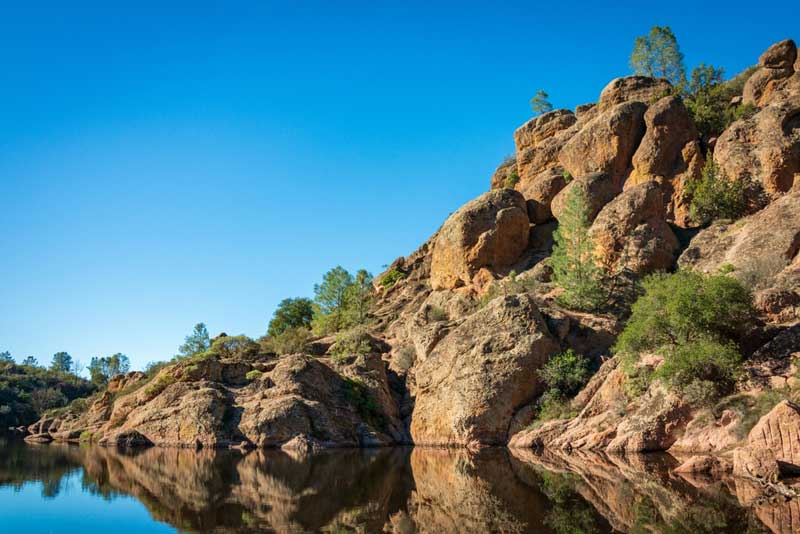
Pinnacles National Park
The Balconies Cave system offers one of the most popular and accessible cave experiences in Pinnacles. These talus caves, formed by massive fallen boulders, create cool, shadowy passages, providing relief from California’s warm climate. They maintain a consistently cool temperature year-round.
The journey to Balconies Cave starts at the Chaparral Trailhead on the west side. It’s a moderate 2.4-mile round-trip hike through diverse ecosystems before descending into the cave system. Inside, you’ll navigate narrow passages and scramble over boulders.
Travel Tips: Bring a flashlight or headlamp as sections can be completely dark. Caves are typically open year-round, but seasonal closures may occur for bat protection. Wear sturdy hiking shoes with good grip. Not recommended for those with claustrophobia or mobility issues.
2. Witness California Condors in Their Natural Habitat
Pinnacles National Park is a primary release site for the California condor recovery program. This makes it one of the best places to observe these magnificent birds. With wingspans up to 10 feet, condors are awe-inspiring creatures that nearly went extinct.
Best viewing opportunities are from the park’s high peaks and ridges, especially around the High Peaks area and along the Condor Gulch Trail. Early morning and late afternoon are optimal viewing times when condors are most active, soaring on thermals.
Travel Tips: Bring binoculars for the best viewing. Rangers often set up spotting scopes. Respect viewing distances and never approach or feed condors. Check with park rangers for current condor activity.
3. Conquer the High Peaks Trail Challenge
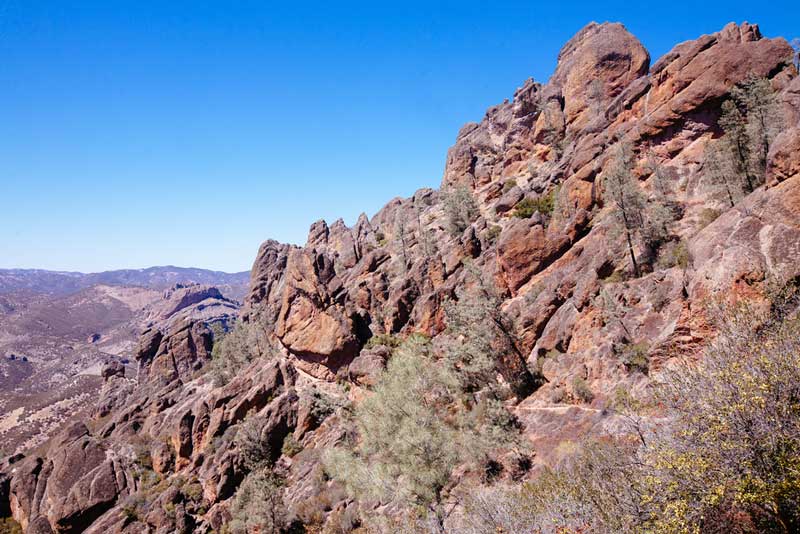
High Peaks Trail
The High Peaks Trail is Pinnacles National Park’s most iconic and challenging hiking experience. It offers breathtaking panoramic views and an up-close encounter with dramatic rock formations. This strenuous 5.3-mile loop gains over 1,300 feet and includes sections with handholds and footholds carved into the rock.
The trail begins at the Bear Gulch Day Use Area and climbs steadily. Views become increasingly spectacular as you ascend. The highlight is reaching the high peaks, where massive volcanic spires create an otherworldly landscape.
Travel Tips: Start early to avoid heat and crowds. Bring plenty of water (at least 2 liters per person) and sun protection. The trail can be dangerous in wet conditions. Not recommended for those with a fear of heights or young children. Allow 4-6 hours.
4. Discover the Mysterious Bear Gulch Cave
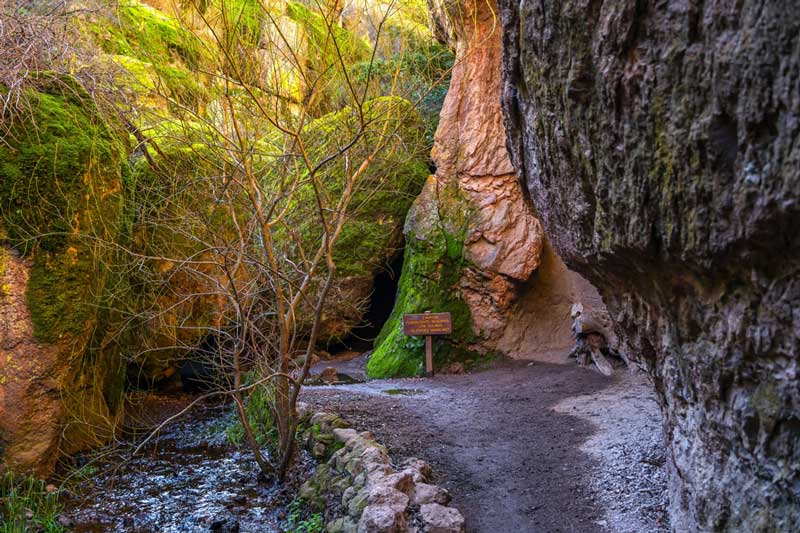
Bear Gulch Cave
Bear Gulch Cave offers a different caving experience than Balconies Cave, with multiple levels and chambers. These seasonal caves provide habitat for Townsend’s big-eared bats and are periodically closed to protect them.
The cave system features narrow passages and cathedral-like chambers. The cool, moist environment supports unique plant life at the entrances. The journey begins with a moderate hike through scenic Bear Gulch.
Travel Tips: Check cave closure status before visiting; it’s typically closed mid-May through mid-July. Bring multiple light sources and extra batteries. The cave can be muddy, so wear appropriate footwear. Helmets are recommended for taller visitors.
5. Experience World-Class Rock Climbing
Pinnacles National Park is a premier rock climbing destination, attracting climbers globally. The park offers over 400 established routes, from beginner-friendly traditional climbs to challenging multi-pitch adventures.
The park’s volcanic rock (rhyolite and dacite) provides excellent grip. Popular climbing areas include the Balconies, High Peaks, and Machete Ridge. The climbing season typically runs from October through April.
Travel Tips: Climbing permits are not required, but follow Leave No Trace principles and respect seasonal closures. Bring plenty of water and start climbs early. Consider hiring a local guide if new to the area.
6. Hike the Scenic Condor Gulch Trail
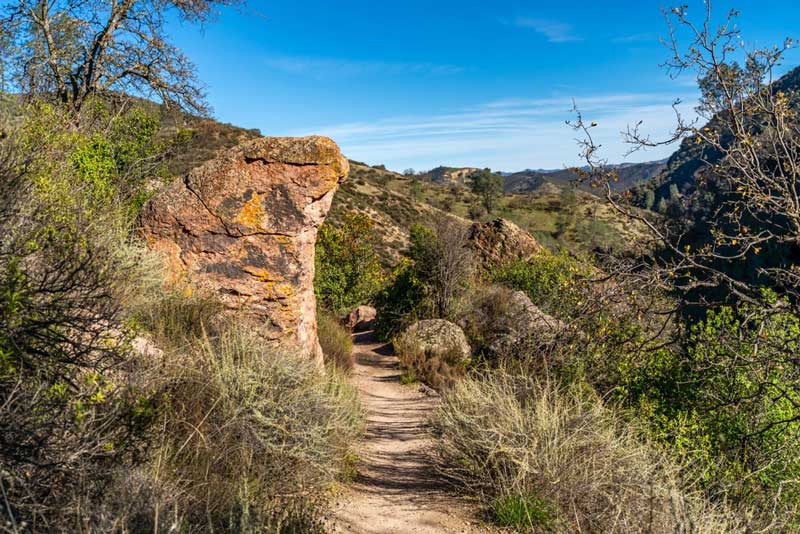
Condor Gulch Trail
The Condor Gulch Trail offers a rewarding moderate hike. It combines accessibility with spectacular views and excellent wildlife viewing opportunities. This 4.7-mile round-trip trail introduces you to the park’s diverse ecosystems.
The trail begins at the Bear Gulch Day Use Area and gradually climbs. Views become increasingly dramatic as you gain elevation. The namesake overlook provides one of the best vantage points for condor viewing.
Travel Tips: Bring binoculars and a camera. The trail is moderately strenuous, so pace yourself and bring adequate water. Early morning hikes offer the best wildlife viewing and comfortable temperatures. Excellent for sunrise or sunset photography.
7. Explore the Unique Chaparral Ecosystem
Pinnacles National Park protects one of California’s most diverse chaparral ecosystems, with over 400 plant species adapted to the Mediterranean climate. This environment features drought-resistant shrubs, wildflowers, and unique plant communities.
Spring brings spectacular wildflower displays. Visitors can discover colorful poppies, lupines, and numerous endemic species. This botanically diverse environment supports impressive wildlife.
Travel Tips: Visit during spring (March-May) for the best wildflower displays, depending on winter rainfall. Bring a plant identification guide. Stay on designated trails. The visitor center offers guided nature walks.
8. Photograph the Stunning Geological Formations
Pinnacles National Park offers endless opportunities for photography enthusiasts. Dramatic rock formations, diverse wildlife, and changing light create perfect subjects. The park’s unique geological features provide unique compositional elements.
Golden hour light during sunrise and sunset transforms the volcanic rock into glowing sculptures. The park’s diverse ecosystems provide subjects from macro photography to wildlife photography.
Travel Tips: Bring a sturdy tripod for low-light photography. Be prepared to adjust camera settings frequently due to rapid lighting changes. Telephoto lenses are essential for wildlife. Respect viewing distances.
9. Discover Hidden Water Features and Seasonal Streams
While known for rock formations, Pinnacles also features seasonal water features that create unique ecosystems. Bear Gulch Creek flows year-round in most years, creating a riparian environment.
These water features attract wildlife and create microclimates supporting lush vegetation. Timing your visit can enhance your experience, with spring and early summer offering the best water flow.
Travel Tips: Visit during spring months for the best water flow. Bring a water filtration system if treating natural sources, but check current water quality with rangers. Areas can be muddy after rain.
10. Experience Night Sky Viewing and Astronomy
Pinnacles National Park’s remote location and limited light pollution make it excellent for stargazing and astronomy. Dark skies reveal thousands of stars and clear views of the Milky Way.
The park occasionally offers ranger-led astronomy programs with telescopes. The combination of dark skies and dramatic rock formations creates unique opportunities for night photography.
Travel Tips: New moon periods provide the darkest skies. Bring red flashlights to preserve night vision. Check program schedules for ranger-led events. Dress warmly as temperatures drop significantly after sunset.
11. Enjoy Birdwatching Beyond the Condors
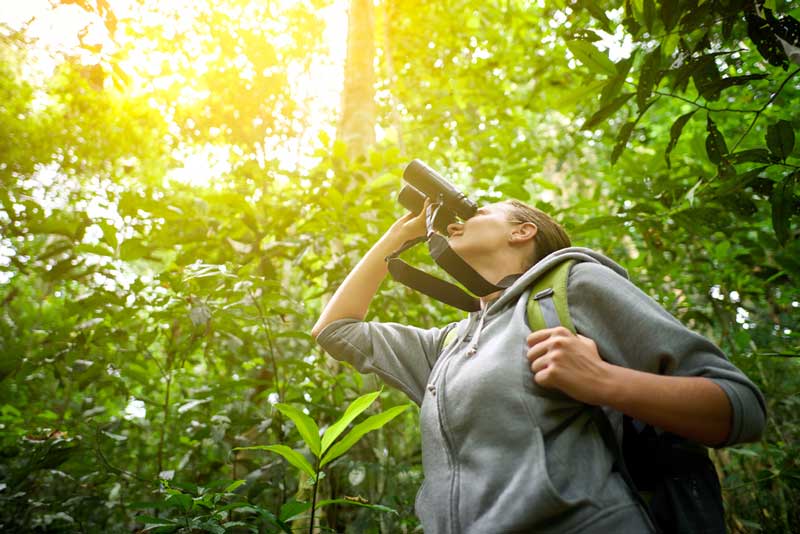
Beyond California condors, Pinnacles National Park supports over 180 bird species, making it a premier birdwatching destination. Diverse habitats support everything from hummingbirds to large raptors.
Riparian areas along Bear Gulch Creek attract different species than chaparral-covered hillsides. Rock formations provide nesting sites for raptors and cliff-dwelling species.
Travel Tips: Bring binoculars and a bird identification guide. Early morning and late afternoon offer the best birdwatching opportunities. Explore multiple locations. Check eBird reports for recent sightings.
12. Explore the Historic CCC and Ranch Heritage
Pinnacles National Park preserves important cultural history, including remnants of the Civilian Conservation Corps (CCC) era and ranching heritage. The CCC worked extensively here in the 1930s, building trails and facilities.
The park’s human history includes Native American presence, Spanish colonial influences, and the ranching era. Interpretive exhibits at the visitor center and along trails explain human impact.
Travel Tips: Visit the visitor center for cultural history exhibits. Look for CCC-era stonework along major trails. Some historic ranch buildings are still visible.
13. Challenge Yourself on the Steep Juniper Canyon Trail
The Juniper Canyon Trail offers a strenuous hiking experience with spectacular views. This challenging 4.2-mile round-trip trail gains significant elevation quickly, making it one of the park’s most demanding routes.
The trail passes through diverse plant communities and provides access to remote and pristine areas. Views from higher elevations encompass the entire park and beyond.
Travel Tips: Recommended only for experienced hikers in good physical condition. Start early to avoid heat. Bring more water than you think and consider trekking poles. Particularly challenging in hot weather.
14. Participate in Junior Ranger Programs
Pinnacles National Park offers excellent educational opportunities for young visitors through its Junior Ranger program and family-friendly activities. Children learn about the park’s geology, wildlife, and conservation.
The program includes hands-on activities, guided walks, and educational materials. Kids can learn about California condors, explore caves safely, and understand environmental protection.
Travel Tips: Pick up Junior Ranger booklets at the visitor center. Programs are typically offered on weekends and school holidays. Some activities require advance registration. Designed for ages 6-12, but younger children can participate with adult assistance.
15. Experience Seasonal Wildflower Blooms
Pinnacles National Park transforms into a colorful wildflower paradise during spring (typically March through May). The park’s diverse microclimates support numerous wildflower species, from poppies to rare endemics.
The intensity and timing of blooms depend on winter precipitation. Wet years produce spectacular displays. Varied elevations mean different areas bloom at different times, extending the season.
Travel Tips: Check the park’s website or social media for current wildflower reports. Bring a camera with macro capabilities. Stay on designated trails to protect fragile plant communities. Visitor center staff can recommend the best viewing areas.
Meet the top attractions in USA, here is a guide on the top things to do in Mesa Verde National Park and the things to do in White Sands National Park.
Local Travel Tips and Practical Information
Transportation and Access
Pinnacles National Park is split into two sections connected by hiking trails but not by roads through the park. The east entrance, accessed via Highway 25, provides the most comprehensive visitor facilities including the main visitor center, campground, and access to popular attractions like Bear Gulch Cave and the High Peaks Trail. The west entrance, reached through the town of Soledad, offers access to Balconies Cave and the Chaparral Trailhead but has limited facilities.
Nearby Towns and Services
The closest town with comprehensive services is Hollister, approximately 35 miles from the east entrance, offering hotels, restaurants, and grocery stores. King City and Soledad provide closer options with basic services and dining. The historic town of San Juan Bautista, about 45 minutes from the park, offers charming accommodations and excellent dining options for those seeking a more cultural experience.
Where to Stay
The park’s only campground is located at the east entrance, offering 99 sites for tents and RVs up to 32 feet long. Reservations are strongly recommended, especially during peak season (October-May). For those preferring hotels, options include accommodations in Hollister, King City, or the more distant but charming Carmel-by-the-Sea or Monterey areas.
Best Times to Visit
The optimal visiting season runs from October through April when temperatures are most comfortable for hiking and outdoor activities. Spring months (March-May) offer the best wildflower displays and most pleasant weather, while fall provides excellent conditions with fewer crowds. Summer can be extremely hot, with temperatures often exceeding 100°F, making early morning visits essential.
Weather Considerations
Pinnacles experiences a Mediterranean climate with hot, dry summers and mild, wet winters. Daily temperature variations can be significant, with cool mornings and evenings even during summer months. Always check weather forecasts and be prepared for changing conditions, especially during winter months when storms can make trails muddy and potentially dangerous.
Frequently Asked Questions
How long should I plan to spend at Pinnacles National Park?
Most visitors find that 2-3 days provides adequate time to experience the park’s major attractions, including both cave systems, several hiking trails, and wildlife viewing opportunities. Day visitors can see highlights like one cave system and a moderate hike, but overnight stays allow for more thorough exploration and better wildlife viewing opportunities during dawn and dusk hours.
Are the caves suitable for children and beginners?
Balconies Cave is generally more suitable for families and beginners, featuring wider passages and easier navigation compared to Bear Gulch Cave. However, all caves require some scrambling over rocks and navigation through narrow passages. Children should be comfortable in dark, enclosed spaces and able to follow safety instructions carefully. Flashlights are mandatory, and adult supervision is essential.
What should I know about California condor viewing?
California condors are wild animals and sightings cannot be guaranteed, but Pinnacles offers some of the best viewing opportunities in the world. Early morning and late afternoon provide optimal viewing times when condors are most active. Binoculars are essential for good viewing, and patience is required as condors may not be visible every day. The park’s visitor center provides current information about recent sightings and best viewing locations.
Conclusion
Pinnacles National Park offers an extraordinary blend of geological wonders, diverse wildlife, and outdoor adventures that make it one of California’s most rewarding destinations. From the thrill of exploring underground cave systems to the awe-inspiring sight of California condors soaring overhead, this unique park provides experiences that connect visitors with both natural beauty and conservation success stories.
Ready to explore more of California’s incredible national parks? Consider visiting nearby destinations like Yosemite, Sequoia, or the stunning coastal landscapes of Big Sur. Each offers its own unique adventures and natural wonders that complement the Pinnacles experience perfectly.
